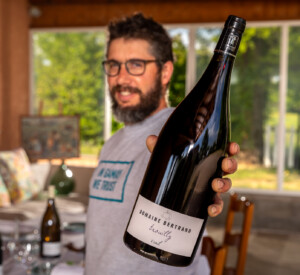Domaine Bertrand

Julien Bertrand
About
Owner & winemaker: Julien Bertrand
Vineyards: 14ha across 40 different rented parcels
Vineyard management: Certified organic since 2020
Soils: Clay, silt, clay-limestone, granitic sand
Grapes grown: Gamay, Chardonnay
Annual production: 55,000 bottles
Quick facts:
- Domaine Bertrand farms vineyards in six of the twelve appellations of Beaujolais, allowing them to produce Gamay in a wide range of styles, from fruity to structured, as well as a white from Chardonnay.
- “For me, speaking of vinification is reductive, because 80% of the wine is made in the vineyard. That’s why we put our greatest effort and care into producing the best quality grapes possible, as naturally as possible.” – Julien Bertrand
Julien Bertrand returned to the family domaine ten years ago, after a career in international business. His grandfather established the property in 1956, making Julien the third generation to farm here. Today, Domaine Bertrand has plantings in six out of the twelve Beaujolais appellations. With a significant diversity of aspect, elevation, and terroir, they’re able to produce a wide range of styles, from fruit-forward, easy-drinking expressions to more structured, tannic, and age-worthy examples. “I love my region because you can always find a Beaujolais that works for you,” Julien tells us.
The vineyards have been certified organic since 2020, and they’ve begun incorporating principles of agroforestry, including cover crops. The goal is to create a balanced environment that will help the vineyards be more resistant to climate change. Julien is also gradually replanting the older, denser vineyards that are difficult to farm with wider rows and fewer plants per hectare. “Beaujolais is in the process of evolving but is without a doubt, a region of the future,” he asserts.
The goal in the cellar is to produce wines that express their terroir and the vintage. Grapes are picked by hand and whole bunches are macerated semi-carbonically, as is traditional. No sulfur is added during vinification, and intervention is kept to a minimum. “Our principal intervention is simply deciding the length of the macerations and the temperature, according to the style of each cuvée,” Julien explains. “But for me, speaking of vinification is reductive, because 80% of the wine is made in the vineyard. That’s why we put our greatest effort and care into producing the best quality grapes possible, as naturally as possible.”

